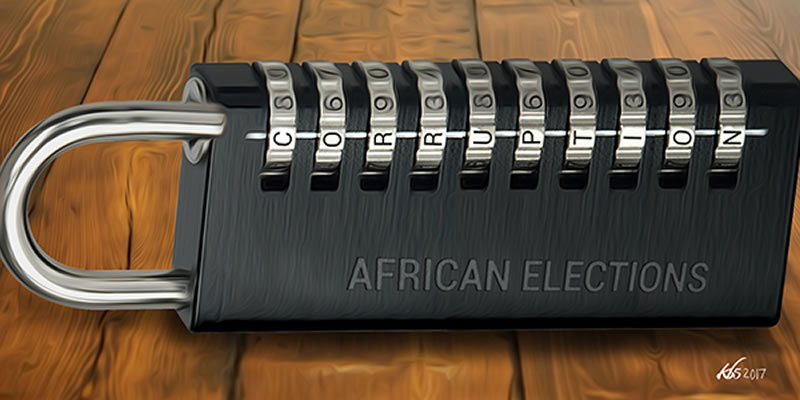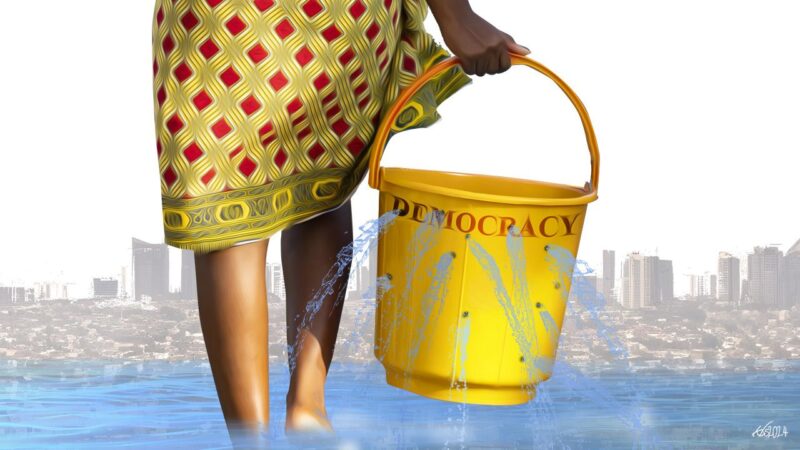There we go again.
The Election Observation industry has generated a sharp backlash from Kenyans in being reported and perceived to have assertively blessed a hotly contested election process that was ultimately thrown out by the Supreme Court of Kenya as not meeting the minimum standards of the Constitution and Election Law. Soul searching is seriously in order.
Whether such serious introspection will happen or not is an open question. So far there have been no explanations that involve any type of concession or apology. No clear displays of humility or a sense of humour about the perceived “egg on the face”. Some groups have offered limited defensiveness and there have been a few counterclaims that Kenyans who are disappointed and/or offended fail to understand the role or work of the international observers or the internationally funded domestic observation operation. Others have been quiet and still have the opportunity to respond in a way that may help regain some confidence from Kenyan voters.
There are a few points that seem pretty obvious. A huge problem is in the communication approach employed by the major international observation groups. They ended up with a gross overplaying of the value of -and blurred important distinctions between- the actual details of the separate Preliminary Statements issued by the respective organizations on August 10. The Statements were issue the second day after the voting and counting at the polling stations and after it became clear that a fiasco was in the works—yet again—with the breakdown or failure to implement the electronic Results Transmission System, and the failure or refusal of the IEBC to be transparent about the underlying facts.
A huge problem is in the communication approach employed by the major international observation groups. They ended up with a gross overplaying of the value of -and blurred important distinctions between- the actual details of the separate Preliminary Statements issued by the respective organizations on August 10.
In spite of the fact that NDI (the U.S.-funded National Democratic Institute), the Carter Center (the Atlanta, Georgia-based NGO started by former President Jimmy Carter) and the EUEOM (European Union Election Observation Mission) operations had all had significant experience with this result transmission situation in Kenya in either 2007 or 2013, or both, all three went ahead and issued formal Preliminary Statements on an apparently pre-scheduled basis. Even in the especially alarming context of the shock of the murder of the IEBC Acting ICT Director, Chris Msando, days before the election and his replacement by his former boss who had been displaced by the Commission in June for refusing to cooperate in an audit.
In 2007, the EUEOM properly held up on issuing a Preliminary Statement after the voting given the problems with the tally (the ECK having shelved shortly before the election laptop computers purchased for them by USAID to transmit results, as we learned from the Kreigler Report). The EUEOM issued that Preliminary Statement on January 1, 2008; the second day after the ECK stopped its tally and announced a “final result”. IRI (the International Republican Institute, American counterpart with NDI) where I was Country Director and Chief of Party for the USAID-funded Election Observation was criticized, rightly in my view, for going ahead with its Preliminary Statement earlier, two days after voting with the tally still ongoing. (I would note, however, that our IRI 2007 Preliminary Statement was quite circumspect and was misunderstood by the Kenyan or international media covering it to conclude that the election was “credible” or “free and fair” or something of the sort, when the process was still ongoing.) Yet that is exactly what happened this year. I pushed assertively internally, as one of the four people who had a hand in the drafting of that Preliminary Statement (the others from Washington), to keep the Statement as reserved/conservative as possible, even though I did not yet know that the tally had been subverted.
If you take time to track down and read the Preliminary Statements (available here at The Elephant) you will notice that the EUEOM written Preliminary Statement is quite circumspect—as far as this statement goes on paper, it looks professional to me and I did not see any obvious errors at the time. The NDI Statement is much more “forward leaning” in parts, and uses the fateful word “credible” early on to describe the overall process in such a way that the Statement was obviously going to be used by others to trivialize the legal and process concerns that were already apparent and anything else irregular that might happen in the ongoing process after August 10. The NDI Statement also has one factual error that I consider to be significant and one other important characterization that I question. Nonetheless, read carefully as a whole the NDI statement does not really on paper provide the type of benediction for a successful election that was claimed by the editorial pages of the New York Times and the Washington Post and then the Trump White House spokesman on August 14.
The NDI Statement is much more “forward leaning” in parts, and uses the fateful word “credible” early on to describe the overall process in such a way that the Statement was obviously going to be used by others to trivialize the legal and process concerns that were already apparent and anything else irregular that might happen in the ongoing process after August 10.
The Carter Center Preliminary Statement is between that of the EUEOM and NDI. It is shorter and has less overall context material than NDI and less detail on the mechanics of the election itself than the EUEOM. To me it suggests a misunderstanding of the import of the electronic Results Transmission System and an overly optimistic notion of alternatives, but it is to my way of thinking clear that the process is very much outstanding and “To Be Determined” and avoids the use of overall characterizations that will inevitably be read as conclusory like NDI’s “credible”. This is what the Carter Center report actually says about the vote tally and transmission:
The mystery is how these formal written reports were then translated into the expansive words of advocacy of John Kerry as the co-lead delegate of the Carter Center delegation. Kerry as quoted in numerous sources went way beyond his brief as Carter Center Delegate. I could speculate why, but I should not have to and will not here. But I have to say that it was inevitable that Kerry, as the immediate past Secretary of State—who represented the United States and President Obama in visiting Kenya after Obama’s 2015 trip and who was Ambassador Godec’s boss in the State Department in handling American diplomacy in Kenya’s 2013 election—was the “big dog” for the media and that his words would trump not only those of others speaking for election observations, but undoubtedly the relative “fine print” of the actual written Preliminary Statements. If I was a volunteer member of an Election Observation Mission and took vacation from my job without my family to undertake the effort, I suspect I would be aggrieved at what Kerry said.
It may very well be that Kerry was simply doing what he thought made the most sense in attempting to play a diplomatic “peace making” role without being much aware of the context of the darker sides of Kenyan politics and the history of struggle behind the hopes of Kenyan to have their votes counted. Regardless, many Kenyans considered his approach deeply condescending and out of place—and if his role was to help then causing offense in this way is a problem in and of itself.
I can say from experience, and it should be obvious to all, that no one at an NGO like the Carter Center was likely to have much success “scripting” the immediate past Secretary of State, unless he asked to be scripted. So no one that works at the Carter Center is necessarily at fault for what happened unless it was their idea to recruit Kerry for this unfamiliar new role and did not get his full buy in. Regardless, it is done now, so it is time for the organizations and donors involved to seriously take stock of why it happened, how to make amends, and how to make sure it does not happen again.
The mystery is how these formal written reports were then translated into the expansive words of advocacy of John Kerry as the co-lead delegate of the Carter Center delegation. Kerry as quoted in numerous sources went way beyond his brief as Carter Center Delegate.
One obvious question is: What the rationale was for USAID to fund two separate “independent international election observation missions”? This has not been the norm in the past. In the last election in Nigeria there were two parallel U.S.-funded Election Observation Missions, but these were from NDI and IRI so you could at least make the distinction based on the relationships with the respective American political parties and their leaders. Further, the observations in Nigeria were funded by the State Department itself, not by USAID.
I wrote here in The Elephant back three months ago a summary of the story of my experience with managing an election observation program and the exit poll program for the ill-fated 2007 election: “THE DEBACLE OF 2007: How Kenyan Politics Was Frozen and an Election Stolen with US Connivance”.
As I noted then, in 2013 I consulted briefly with AfriCOG on “observing the election observers” based on my prior experience and came back to witness the voting and in particular to observe and interact with the Observation Missions.
Kenya’s leaders have historically proven quite skillful in stealing their own elections as necessary. They do not really need help from Westerners, although they have been in the habit of hiring and paying for Western consultants for their campaigns. So there is no actual need for us to “observe” these elections unless we are quite committed to add value by being thoroughly independent and credible to level the playing field a small bit in favor of the wananchi voter.
Following the Kenyan Supreme Court decision on the Presidential Petition, many Kenyans on social media have said explicitly, or implicitly, “we got this”. “Thanks for thinking of us, but you are more part of the problem than part of the solution.” Naturally, this makes me sad as an American and I think we ought to straighten this out.
Unfortunately, even in 2013, I made an unforced error, a mistake, in spite of my sobering experience from 2007. A few days after coming to Nairobi, as a favor to a friend (who probably thought he was doing a favor for me) I did a scheduled live television interview where I spent a long time in open-ended discussion about the elections. This turned out to take place shortly after then-Chairman of the IEBC, Issack Hassan, had announced he was shutting down the electronic Results Transmission System (“RTS”). Later I was quoted and criticized in a news story in The Star newspaper for saying on television the shutdown of the RTS was “not alarming”. In fuller context my “observation” was not quite as bad in the sense that I said that the situation then would turn on how the IEBC handled the original paper Forms 34 and that I would give the election an overall 5 of 10 rating at that point which would move up or down directly on that question.
Kenya’s leaders have historically proven quite skillful in stealing their own elections as necessary. They do not really need help from Westerners, although they have been in the habit of hiring and paying for Western consultants for their campaigns.
Nonetheless, I simply was not deeply enough informed to realize what was really happening at the IEBC and should not have been addressing it on live television in real time. I was not speaking for anyone other than myself but I did not turn out to be right. “Not alarming” came from a gut reaction of not wanting to be provocative, not wanting to “incite” or disrupt the pervasive “peace narrative”—all a part of that situation of being “stuck” from 2007 that my June piece here describes.
In truth, as I found out later, the acquisition of the RTS failed, or so the president of the International Foundation of Electoral Systems (IFES) testified to the U.S. Congress. Thus it was really not some technical situation that happened surprisingly after the vote in the course of a legitimately expected and reliable collection of results, but rather a situation that the key insiders should have known was going to be the case. Eventually, I learned the next year, in 2014, that at the time of the election the IEBC, in spite of the failure to have acquired and have in place the necessary system for the RTS, did not have a plan in place to handle the paper Forms 34 either! Clearly I had made myself a “useful idiot” by not being suitably skeptical of the assurances of the IEBC and its enablers. [I do not think my interview made any actual difference, but it was a cautionary lesson for me.]
After my experiences in two different roles in 2007 and then 2013, I was forced to conclude as the 2017 vote approached this year that as an American I simply was not going to be in a position to be of assistance in the existing environment. The U.S. assistance and observation program in 2007 did not stop the election from being stolen and violence from erupting in response. In 2013, many people in the U.S. government considered the assistance program successful, but from my perspective working with independent civil society, I was not satisfied. Although there was much less violence and “stability” was preserved in a sense, the election itself was clearly very badly administered, in some ways worse than in 2007. Clearly, to my way of thinking, Kenyan voters who deserved to have their votes counted were sold short. The Preliminary Statements of international observers were used in the Supreme Court by lawyers paid by the Government of Kenya to litigate against civil society on the election petition (as they use were this year, along with a clip of John Kerry speaking).
Eventually, I learned the next year, in 2014, that at the time of the election the IEBC, in spite of the failure to have acquired and have in place the necessary system for the RTS, did not have a plan in place to handle the paper Forms 34 either!
Recently I learned more about what happened in 2013. Back in 2015 I sent a Freedom of Information Act request to USAID to learn about the details of the US assistance program for that election, including whatever might turn up on the technology acquisitions. By early 2016, roughly 1800 documents had been sent from Nairobi to Washington to be reviewed for production under my request, but it was only this summer that I got release of a first group of just over 200 pages. This was just a heavily redacted copy of the “cooperative agreement” for U.S. assistance for the election between the consortium of IFES (the International Foundation of Election Systems), NDI and IRI. This provided for voter education and various training activities through NDI and IRI, but also provided for embedded technical assistance by IFES in the IEBC—continuing the role IFES has played since 2002. The agreement stressed the vital importance of the electronic Results Transmission System and provided for USAID through IFES to pay for building it out to meet the needs of the General Election having been used in the 2010 Constitutional Referendum. I am hoping to learn eventually through release of the additional documents what happened to the ill-fated acquisition. I am not comfortable, personally, saying too much about the 2017 election until I understand more about 2017—other than I will note that I do not think the Supreme Court had much choice in this year’s case unless they were just going to say “anything goes” for the future.
Following the Kenyan Supreme Court decision on the Presidential Petition, many Kenyans on social media have said explicitly, or implicitly, “we got this”. “Thanks for thinking of us, but you are more part of the problem than part of the solution.”
In the meantime, there is a lot of troubling history involving the IEBC in 2016 and 2017 and the use and acquisition of the KIEMS this year—entirely aside from anything related to the Msando murder–that seems to have been wholly ignored by the Election Observation Missions, even in their formal written Preliminary Statements. Likewise, the attacks by the President and others in government on IFES and USAID in December. Based on this it could be argued that the Election Observation Missions were simply not prepared or not willing to get into the nitty gritty of the completion for political power through elections in Kenya in such a way as to actually serve Kenyan voters as a whole. And if observers are just serving diplomatic interests of donors, they should just call themselves diplomatic observers and not claim to be independent or a part of a separate mission to assist Kenyans.








